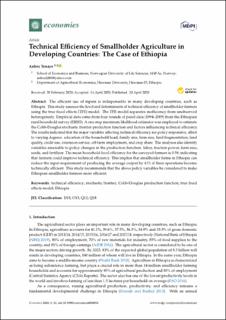Technical Efficiency of Smallholder Agriculture in Developing Countries: The Case of Ethiopia
Peer reviewed, Journal article
Published version
Permanent lenke
https://hdl.handle.net/11250/2755687Utgivelsesdato
2020Metadata
Vis full innførselSamlinger
Sammendrag
The efficient use of inputs is indispensable in many developing countries, such as Ethiopia. This study assesses the level and determinants of technical efficiency of smallholder farmers using the true fixed effects (TFE) model. The TFE model separates inefficiency from unobserved heterogeneity. Empirical data come from four rounds of panel data (1994–2009) from the Ethiopian rural household survey (ERHS). A one-step maximum likelihood estimator was employed to estimate the Cobb-Douglas stochastic frontier production function and factors influencing technical efficiency. The results indicated that the major variables allocating technical efficiency are policy responsive, albeit to varying degrees: education of the household head, family size, farm size, land fragmentation, land quality, credit use, extension service, off-farm employment, and crop share. The analyses also identify variables amenable to policy changes in the production function: labor, traction power, farm size, seeds, and fertilizer. The mean household-level efficiency for the surveyed farmers is 0.59, indicating that farmers could improve technical efficiency. This implies that smallholder farms in Ethiopia can reduce the input requirement of producing the average output by 41% if their operations become technically efficient. This study recommends that the above policy variables be considered to make Ethiopian smallholder farmers more efficient.
